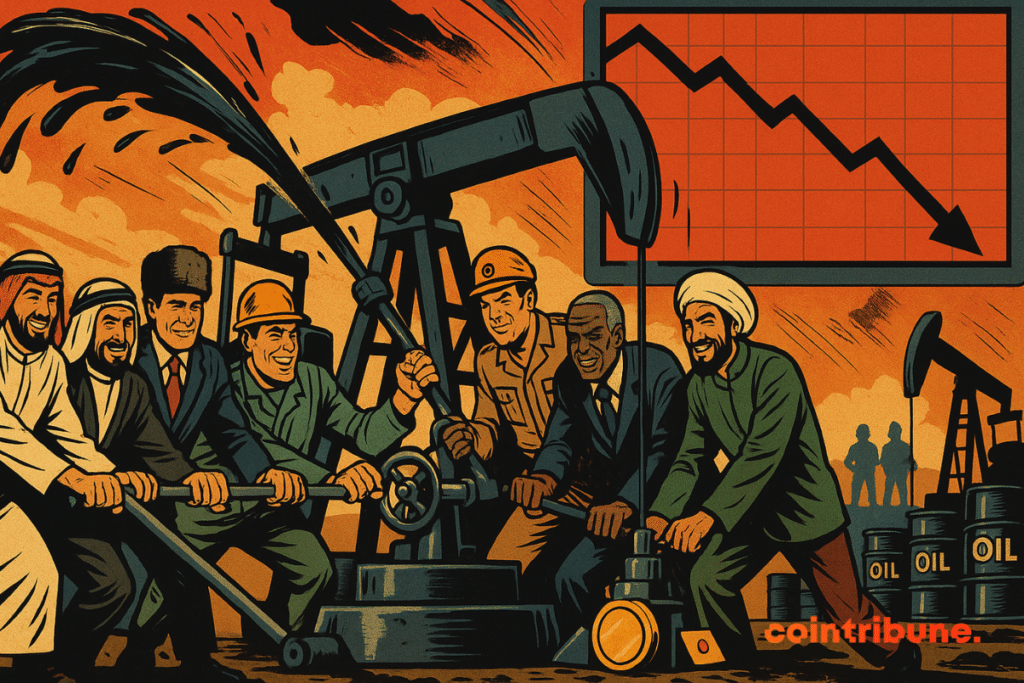8 OPEC+ Countries Increase Oil Production Despite Falling Prices
While oil prices are plummeting and demand remains sluggish, OPEC+ surprises by announcing a massive increase in its production starting in June. Eight cartel members break with recent caution and rekindle uncertainty in an already strained market. Behind this reversal lies a possible geopolitical and economic turning point, between a strategy of reconquest and calculated risk-taking. This decision could well redraw the global energy balances.

In brief
- Eight OPEC+ members, including Saudi Arabia and Russia, announce a massive increase in oil production starting in June 2025.
- This increase reaches 411,000 barrels per day, three times more than the initially planned 137,000.
- This maneuver could also strengthen diplomatic relations between Riyadh and the Trump administration, which had called for more production.
- In the medium term, this change of course could rekindle a price war and disrupt the balance of global oil markets.
An unexpected surge: OPEC+ triples its pace
The announcement was published this Saturday, May 3, 2025. Eight member countries of OPEC+ will produce an additional 411,000 barrels per day from June, the same level as in May, which overturns the initial plan that only foresaw 137,000.
This decision involves countries at the heart of the cartel such as Saudi Arabia, Russia, Kuwait, Algeria, and Oman. Analyst Jorge Leon from Rystad Energy did not mince words and declares:
OPEC+ has just dropped a bombshell on the oil market.
This statement reflects the magnitude of the shock inflicted on markets already weakened by sluggish global demand.
The details of the turnaround confirm a profound strategic shift within the cartel. Where OPEC+ had until now favored caution and targeted cuts to support prices, it now adopts an aggressive supply policy, motivated by market share stakes. Here are the key points of this reorientation:
- The quantity involved: 411,000 additional barrels per day will be put on the market in June, three times more than the initially planned 137,000;
- The countries involved: Saudi Arabia, Russia, Iraq, the United Arab Emirates, Kuwait, Kazakhstan, Algeria, and Oman, some of which belong to the BRICS alliance;
- The stated justification: a desire to break with a scarcity strategy that has prevailed since the 2016 OPEC+ agreement.
- Market context: current oil prices are around 60 dollars per barrel, historically low for such a restart.
This turning point occurs in an already pressured environment and is one of the most significant gestures by the cartel since the COVID-19 pandemic. The message is clear: OPEC+ leaders no longer wish merely to manage market balance; they intend to reclaim it.
Hidden objectives and geopolitical balances
Beyond the numbers, the initiative bears the mark of a carefully calibrated political calculation. By intensifying their production, OPEC+ countries are not only seeking to flood the market. They are also sending a strategic message to the United States, particularly to the Donald Trump administration.
This massive valve opening partially responds to an explicit demand from Washington: “Shortly after taking office, the American president had asked Saudi Arabia to produce more to lower prices.” By acting this way, Riyadh could hope to strengthen its ties with the White House and obtain, in return, some easing of diplomatic or trade pressures.
Another underlying issue, rarely publicly mentioned, is the management of internal dissensions within the cartel. Several experts propose the idea that this production increase would aim to sanction “cheating” OPEC+ members, those who do not always respect quotas.
By increasing volumes available on the market, the group leaders put indirect pressure on these actors, forcing them to choose between alignment or marginalization. It could also reflect a desire to crush the margins of producers outside OPEC+ in Latin America or Sub-Saharan Africa, less able to survive lower prices.
In the medium term, this strategy could profoundly reshuffle the cards. By favoring abundance over scarcity, OPEC+ takes the risk of a prolonged collapse of crude prices, a dangerous bet for economies largely dependent on this rent. If markets see this as a return to a price war, consequences could also extend to energy policies, the currencies of producing countries, and the stability of emerging markets. This change of course will therefore have repercussions far beyond the oil sector. It could sustainably influence investors’ strategic choices, including in the crypto ecosystem, intrinsically linked to global markets.
Maximize your Cointribune experience with our "Read to Earn" program! For every article you read, earn points and access exclusive rewards. Sign up now and start earning benefits.
Diplômé de Sciences Po Toulouse et titulaire d'une certification consultant blockchain délivrée par Alyra, j'ai rejoint l'aventure Cointribune en 2019. Convaincu du potentiel de la blockchain pour transformer de nombreux secteurs de l'économie, j'ai pris l'engagement de sensibiliser et d'informer le grand public sur cet écosystème en constante évolution. Mon objectif est de permettre à chacun de mieux comprendre la blockchain et de saisir les opportunités qu'elle offre. Je m'efforce chaque jour de fournir une analyse objective de l'actualité, de décrypter les tendances du marché, de relayer les dernières innovations technologiques et de mettre en perspective les enjeux économiques et sociétaux de cette révolution en marche.
The views, thoughts, and opinions expressed in this article belong solely to the author, and should not be taken as investment advice. Do your own research before taking any investment decisions.